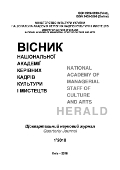THE EFFECT OF ENVIRONMENTAL PROMOTION ON CULTURAL INTELLIGENCE OF MUNICIPAL EMPLOYEES OF DISTRICT SEVENTEEN
DOI:
https://doi.org/10.32461/2226-3209.1.2018.177674Анотація
Abstract. The most high and the highest level of involvement in society is the culture of that society. The basic principle of society is the identity and existence of that society, and the place of advertising in general is one of the most important and influential elements in the culture of every society, because today man is constantly exposed to urban advertising bombardment And with the expansion of the media, these ads are becoming more common. Given the increasingly interconnected world and organizations increasingly need more advertising and cultural diversity, they are vital and essential. That individuals have the knowledge and skills to effectively address the challenges and needs of a
community They are facing The result of diverse cultural environments is that people face values, assumptions, and desires and expectations that are fundamentally different from their own values and assumptions. It is believed that cultural intelligence explains why some people are more skilled in guiding culturally different environments than other people. In this regard, the research studies the impact of environmental advertising on cultural intelligence of municipal employees in
District 17 as An organization that operates at the Tehran metropolitan area. Data was collected from 86 employees of District 17 municipality by questionnaires. In order to measure cultural intelligence, questions from the standard uestionnaire provided by Ang were used to assess the performance of questions, which were based on the literature review of the field of performance, and both categories of questions were submitted to professors through a questionnaire. Validity It was confirmed and its reliability was 953/0 using SPSS software. The results of the Spearman correlation test showed that
there is a relationship between cultural intelligence of the municipal employees of the 17th district and the urban environmental propagation, there are aspects of cultural intelligence (metacognitive, cognitive, cognitive, behavioral) and communication function. The priority of the cultural intelligence dimensions of the municipal employees of the 17th district was obtained from the Friedman test as follows: Cultural Intelligence, Cultural Behavioral Intelligence, Metacognitive Cultural Intelligence, Cognitive Cultural Intelligence. Based on the results of the mean test of a statistical society, cultural
intelligence, metacognitive cultural intelligence, cognitive cultural intelligence, motivational cultural intelligence, and the amount of urban environmental advertising, there is a favorable relationship
Keywords: Environmental advertising, cultural intelligence, media.
Посилання
Abbott, E. James, "Measuring Quality with Fuzzy logic", The TQM Magazine,1996, Issue: 8, Vol. 4, pp. 36-39.
Aydin S., Ozer G., Arasil O., (2005);" Customer Loyalty and the effect of switching costs as a oderator variable",
Marketing Intelligence & Planning ,Vol. 23, No. 1, p 487.
Berger. Charles, Blauth. Robert, Boger .David, Bolster. Christopher , Burchill.Gary, Dumouchel. William, Pouliot. Fred,
Richter. Reinhard, Allan. Shen,Diane. Timko, Mike. Walden, David. (fall 1993). “Kano „s methods for understanding
customer-defind Quality”, In: Center for Quality management.
Bolton, Rn. & Lemon, Kn. (1999), « A Dynamic Model of Customers Usage of Services: Usage As An Antecedent And
Consequence of Satisfaction », Journal of Marketing Research, Vol. 36, May, P. 171.
Churchill, G. A. and Suprenant, C., "An Investigation in to Determinants of Customer Satisfaction," Journal of Marketing
Research, 1982, Vol. 19, pp 491-504.
Duffy,J.."MeasuringCustomer Capital " , Strategy & Leadership,28,5,ZOOO,pp (10-14).
Engle, J. F. and Blackwell, R. D., 1982, "Health Care Marketing", Jones and Bartlett Publishers.
Fecikova,Ingrid(2004)"An index method for customer satisfaction "The TQM Magazine.
Forsyth. R (2003). “Twelve Simple Steps to customer Loyalty”, available at: www.crm.insightexe.com.
Goodman John ,Mamage Complaints to Enhance Loyalty Quality Progress ; Feb 2006 ; 39,2;ABI/Inform Global , pg 28.
Gotleieb, J., Grenwalt,D., Browns, S.W. Consumer satisfaction and perceived quality :complementary or divergent
construacts. Journal of applied psychology.1990pp69-81.
Gremler, D.D. & Gwinner, Kp. (2000), « Customer-Employee Rapport In Service Relationships », Journal of Service
Research, Vol. 3 No.1, P. 82.
Hunt, K. H., "Measuring Client Satisfaction" "A Taxonomy of Consumer Satisfaction / Dissatisfaction Measures", 1977,
Office of the Comtroller General Evaluation and Audit Branch.
Keki r.bhote. "beyond customers satisfaction to customers loyaty" (new yorkT ny10019)(1996)pp10-19.
Kotler, Philip and Armstrong, Gary, 9th Ed. 2001, "Principles of Marketing",Prentice Hall of United States of America.
Oliver, R. A conceptual model of service quality and service satisfaction. Advances in Services Marketing and
Management, 2. 1993. 65-85.
Palmer, Adrian, 3th Ed. 2000, "Principles of Services Marketing", McGrow Hill.
RAMPERSAD, H. “75 PAINFUL QUESTION ABOUT YOUR USTOMERS SATISFACTION”, THE TQM
MAGAZINE, VOL.13, NO.5, 2001p342.
Roderick m .mcnealy " making customers satisfaction happen " (1994) chapman & hall. Firsted.
Solomon, Michael R. (1999) «Consumer behavior», Prentice Hall, New Jersey,4th ed., p321.
Swartz, treaza,A.(1988).A Gap analysis of professional service quality jornal of marketing 53, 93.
##submission.downloads##
Номер
Розділ
Ліцензія
Автори, які публікуються у цьому журналі, погоджуються з наступними умовами:
1. Автори залишають за собою право на авторство своєї роботи та передають журналу право першої публікації цієї роботи на умовах ліцензії Creative Commons Attribution License International CC-BY, котра дозволяє іншим особам вільно розповсюджувати опубліковану роботу з обов'язковим посиланням на авторів оригінальної роботи та першу публікацію роботи у цьому журналі.
2. Автори мають право укладати самостійні додаткові угоди щодо неексклюзивного розповсюдження роботи у тому вигляді, в якому вона була опублікована цим журналом (наприклад, розміщувати роботу в електронному сховищі установи або публікувати у складі монографії), за умови збереження посилання на першу публікацію роботи у цьому журналі.
3.Політика журналу дозволяє і заохочує розміщення авторами в мережі Інтернет (наприклад, у сховищах установ або на особистих веб-сайтах) рукопису роботи, як до подання цього рукопису до редакції, так і під час його редакційного опрацювання, оскільки це сприяє виникненню продуктивної наукової дискусії та позитивно позначається на оперативності та динаміці цитування опублікованої роботи.

